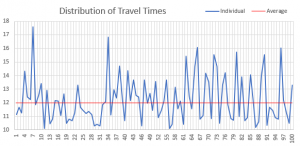The Dangers of Planning with Averages
When it comes to managing supply chains, planning based solely on averages can be a recipe for disaster. While averages can provide a useful snapshot of what to expect, they fail to take into account the random variability that occurs in real-world situations. This can lead to a range of issues, from stock shortages to inefficient use of resources. In this article, we’ll explore why planning a supply chain based on averages is poor, and provide some examples of how this can impact businesses.
What is an average, and why is it problematic?
An average is a measure of central tendency that is calculated by adding up a set of values and dividing them by the number of values in the set. This can be useful when trying to get an overall sense of what is happening, but it is important to remember that averages are just one way of looking at data. Averages can mask important information, such as the range of values that make up the data set, the frequency of different outcomes, and the degree of variation around the mean. Averaging ignores the importance that random variation plays in operations, especially with the ability to predict congestion and minimize storage structures, and manage capacity.
The problem with planning based on averages is that it assumes that the future will be similar to the past. This is not always the case, as random events can cause significant disruptions to supply chains. For example, a sudden surge in demand for a product might cause a stock shortage if the supply chain has been planned based on average levels of demand. Similarly, unexpected delays in shipping or production can throw off supply chain plans if they are not taken into account.
Planning with Averages vs Distributions
There are many examples of how random variability can impact supply chains. One of the most common is the bullwhip effect, which occurs when small fluctuations in demand at the local level are amplified as they move up the supply chain. This can cause significant swings in inventory levels, as suppliers and manufacturers try to anticipate future demand based on incomplete or inaccurate information.
 A static model may consider train travel time, loading time, return travel time and unloading time. Consider the diagram to the left. The train travel time may be an average of 12 hours but in reality it is a distribution between 10 and 18 hours.
A static model may consider train travel time, loading time, return travel time and unloading time. Consider the diagram to the left. The train travel time may be an average of 12 hours but in reality it is a distribution between 10 and 18 hours.
How does that affect the plan and what impact does that variation have on the next step in the supply chain? Every process, every movement will have a distribution of historical times performance. A common cause of congestion or queuing is not accounting for variability, and how that affects the overall supply chain.
Other impacts include:
- Inadequate inventory levels: If the supply chain is planned based on average levels of demand, it may result in inadequate inventory levels during peak periods, leading to stockouts and supply disruptions.
- Inefficient use of resources: If the supply chain is planned based on average levels of production, it may result in inefficient use of resources during periods of low demand, leading to increased costs and reduced profitability.
Conclusion
In conclusion, planning a supply chain based on averages is a poor strategy, as it fails to acknowledge the random variability that occurs in real-world situations. Instead, supply chain managers should use a range of tools and techniques to model different scenarios and prepare for unexpected events. This might include using simulation software to test different scenarios, building in extra capacity to buffer against fluctuations in demand, and maintaining close relationships with suppliers and customers to stay up to date on the latest developments. By taking a proactive and flexible approach, businesses can improve their resilience and better respond to the challenges of a rapidly changing world.
InterDynamics has assisted clients around the world to improve their supply chain planning using their discrete event simulation software Planimate. Contact Us to learn more about our supply chain planning software and Decision Support Systems.
